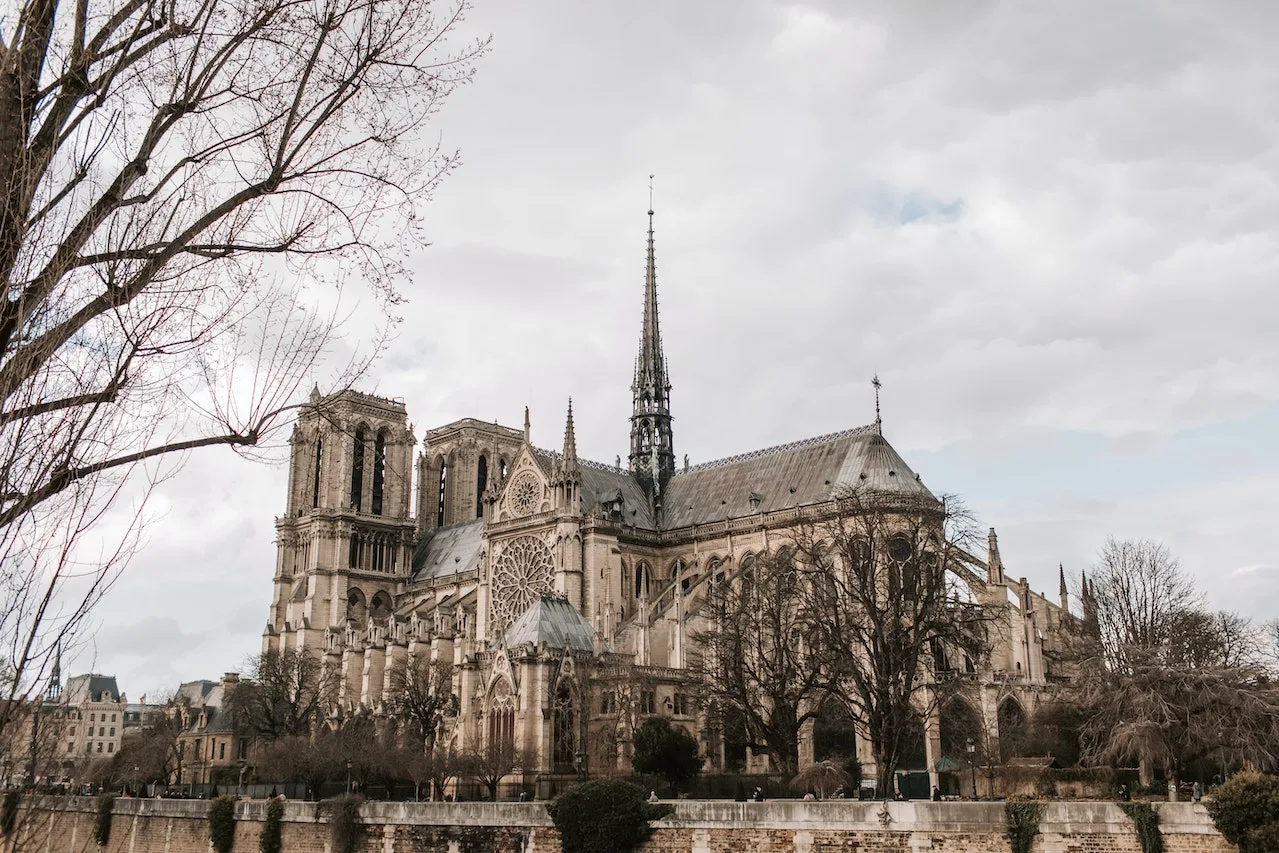A Magical Journey through Gothic Architecture's Timeless Grandeur
Visiting the Enchanting World of Gothic Architecture
So you've heard about Gothic architecture..., but do you actually know what it is? Don't worry, you're not alone. We're here to get you served; it is one of history's most fascinating and influential architectural styles. Characterized by its pointed arches, ribbed vaults, and flying buttresses, this magnificent style has left a lasting impact on the world of architecture.
Step into a realm where stone and light intertwine to create a symphony of ethereal beauty – a world where architecture transcends time, reaching out to touch the souls of those who behold it. Welcome to the captivating kingdom of Gothic architecture, an artistic expression woven into the fabric of history, leaving an indelible mark on the past and present landscapes.
With its soaring spires that seem to kiss the heavens, intricate stone carvings that whisper tales of devotion, and stained glass windows that transform sunlight into kaleidoscopic dreams, Gothic architecture stands as a testament to the boundless creativity and unwavering dedication of human hands and hearts. In this blog post, we'll dive into the history, features, and significance of Gothic architecture. So buckle up and get ready to learn all about this awe-inspiring, unique-of-its-kind architectural style!
 |
| Fig.1- The Notre Dame Cathedral remains an awe-inspiring testament to human aspiration, Photo by Vlada Karpovich |
Gothic Style: Emergence, Historical Evolution, and Main Characteristics
Gothic architecture, similar to an enchanting tale, began its narrative during the late medieval era – a period spanning from the 12th to the 16th centuries. Originating in the heart of France, this architectural marvel soon cast its spell far beyond its birthplace, embracing diverse lands and cultures. This was an era of innovation, a time when architects dared to dream beyond the limits of what had come before.
The key features of the architectural style emerged with pointed arches that reached for the heavens, ribbed vaults that transformed mere ceilings into symphonies of form, and flying buttresses that stood as graceful supports, defying gravity itself.
Main Characteristics: The 9 Elements of Gothic Architecture
Gothic architecture is a style that emerged in Europe during the late Middle Ages, particularly in the 12th to 16th centuries. It is characterized by a distinctive set of architectural features that set it apart from earlier Romanesque and subsequent Renaissance styles.
Some of the main characteristics of Gothic architecture include:
- Vertical Emphasis: One of the most prominent features of Gothic architecture is its verticality. Buildings were designed to reach great heights, with tall, pointed arches, spires, and soaring cathedrals. This vertical emphasis was achieved through the use of pointed arches, ribbed vaults, and pointed elongated windows.
- Pointed Arches: Gothic architecture is known for its use of pointed arches, which replaced the rounded arches of Romanesque architecture. Pointed arches allowed for greater height and flexibility in design, enabling architects to create larger and more complex structures.
- Ribbed Vaulting: Gothic buildings often feature ribbed vaults, which are a system of intersecting arched ribs that support the roof and distribute the weight of the building more effectively. This allowed for larger and more open interior spaces.
- Flying Buttresses: To support the tall walls and intricate windows of Gothic cathedrals, flying buttresses were employed. These external, arched supports helped transfer the weight of the walls and roof to the ground, allowing for thinner walls and larger windows.
- Large Windows and Stained Glass: Gothic architecture is renowned for its extensive use of stained-glass windows. These windows were often decorated with intricate designs and vibrant colors, creating a stunning play of light within the buildings and depicting biblical stories for illiterate congregations.
- Decorative Ornamentation: Elaborate decorative elements such as intricate carvings, sculptures, and intricate stone tracery were common in Gothic architecture. These details often adorned portals, arches, and façades, adding to the overall aesthetic appeal.
- Symmetry and Proportion: Gothic architecture emphasized balance and symmetry in its designs, creating a sense of harmony and order. Proportions were carefully calculated to achieve a pleasing visual effect.
- Nave and Aisle Layout: Many Gothic cathedrals and churches followed a cruciform plan, with a long central nave flanked by aisles. This layout allowed for large congregations to gather for religious services and provided a clear sightline to the altar.
- Use of Pointed Gables and Spires: Gothic architecture often featured pointed gables on the façades of buildings, as well as tall, intricate spires that reached toward the heavens. These elements further emphasized the verticality of the style.
- Regional Variation: While there are common characteristics, there are also regional variations within Gothic architecture. Different regions developed their own unique interpretations of the style, leading to variations in design, decoration, and structural elements.
Gothic architecture played a significant role in shaping the landscape of medieval Europe, with its impressive cathedrals, churches, and other structures serving as expressions of religious devotion, cultural identity, and architectural innovation.
A Historical Odyssey
Picture the quiet town of Saint-Denis, France, in the early 12th century. Amidst its modest streets stood the Basilica of Saint-Denis, poised for a transformation that would change the course of architectural history. It was here that the visionary Abbot Suger embarked on a daring journey. His vision was one of luminosity – he believed that light itself could be a vessel of the divine.
 |
| Fig.2- Basilica of Saint-Denis from inside, Photo-Source: i.pinimg.com |
And so, under his guiding hand, the basilica's stone walls transformed into canvases for stained glass, and its interiors became sanctuaries illuminated by the very essence of life. This sacred metamorphosis marked the birth of Gothic architecture, ushering in an era of innovation that would leave its mark on the world.
Notable Gothic Marvels Around the World
Venture across continents and eras, and you'll discover a constellation of Gothic marvels that have defied time's embrace. Here are some of these marvels:
- Notre-Dame Cathedral, Paris, France: With its intricate rose windows that filter light into a celestial spectrum, and its spires that rise like prayers toward the heavens, Notre-Dame Cathedral remains an awe-inspiring testament to human aspiration. (See the featured image Fig. 1 above)
- Westminster Abbey, London, England: An embodiment of English Gothic grace, the abbey's soaring nave and intricate fan vaulting beckon visitors into a world where craftsmanship becomes poetry.
- Cologne Cathedral, Germany: The Cologne Cathedral's façade stretches toward the skies, a testament to the power of verticality in Gothic design. Its intricate details draw gazes upward as if reaching for a divine embrace.
- Sagrada Família, Barcelona, Spain: Gaudí's magnum opus marries the spirit of Gothic architecture with the innovative flair of Art Nouveau. It stands as a testament to the enduring adaptability of the style and the genius of a single visionary mind. Read more about Gaudi's architecture.
- Milan Cathedral, Italy: The Milan Cathedral's façade, adorned with a multitude of intricate statues, narrates stories of faith, devotion, and human achievement. Its rooftop panorama offers a sweeping view of the city's tapestry.
Visionary Pioneers of Gothic Architecture
As the sun sets on our exploration, we must pay homage to the pioneering spirits who breathed life into the stones of Gothic architecture:
- Abbot Suger: A visionary ahead of his time, Suger's transformative vision at the Basilica of Saint-Denis set the stage for the Gothic Revolution. His pursuit of luminosity and his belief in the divine power of light birthed an architectural era of awe-inspiring beauty. (Fig.2)
- Peter Parler: With his masterful touch on the Saint Vitus Cathedral in Prague, Parler etched his name in the annals of Gothic history. His ability to blend design and structural integrity pushed the boundaries of possibility.
- Viollet-le-Duc: In an age of restoration and revival, Viollet-le-Duc emerged as a guardian of Gothic heritage. His commitment to breathing new life into ancient structures ensured that Gothic architecture's flame would burn bright through the ages.
Final Thoughts
As we stand at the crossroads of past and present, gazing up at the soaring spires and intricate traceries that define Gothic architecture, we are reminded that creativity transcends time. It is a testament to the human spirit's insatiable hunger for beauty, innovation, and connection.
Its legacy lives on, a tangible link between eras, cultures, and souls. So let us continue to be enchanted by the stories these stones tell, and let us walk the hallowed halls of cathedrals, palaces, and sanctuaries that time cannot diminish – for in the heart of these structures, humanity's journey finds its eternal expression.
.png)






